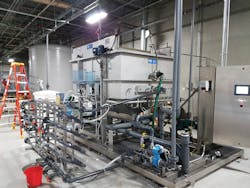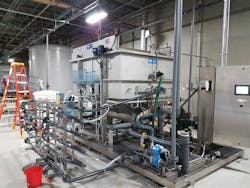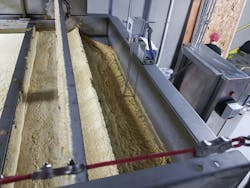New Wastewater Strategy for Mustard Producer
Plochman’s reduces BOD and TSS, cutting sewer discharge fees by 70 percent
By Jim McMahon
At the National Mustard Museum in Wisconsin, more than 5,600 varieties of mustard from all 50 states and more than 70 countries are on display. Among these are mustards manufactured by Plochman Inc., located in Manteno, Ill., on the outskirts of Chicago. Known as “The True Mustard Lover’s Mustard,” Plochman’s is one of the top five brands of mustard consumed in the United States. The company has been a family owned and operated business for more than 150 years, manufacturing a variety of mustard condiments, including classic American yellow, stone ground, spicy, Dijon, beer, Kosciusko and horseradish.
Since 1997, Plochman’s has manufactured and distributed its product line of 11 mustards from the company’s 100,000-square-foot production plant in Manteno. But in 2015, Plochman’s also began manufacturing salad dressings for its sister company, California-based Girard’s Food Service Inc. (GFF), to facilitate a stronger distribution capability for GFF in Midwestern markets.
Changing Wastewater Characteristics
Manufacturing both mustard and salad dressing not only increased the plant’s food production output, it also greatly changed the characteristics of the plant’s wastewater. Low pH wastewater from mustard manufacturing was now combined with wastewater from salad dressing production containing a high content of fats, oils and grease (FOG). The plant’s 12,000 gallons per day (gpd) of effluent presented a more serious challenge for wastewater treatment.
The company’s wastewater originates from wash-down of mixers, filling machines and other process equipment. Prior to the addition of salad dressing production, Plochman’s discharged untreated wastewater directly to the municipal sewer system.
“When we change production runs our processing equipment and pipelines are washed down with water and sanitation chemicals through a clean-in-place system,” said Martin Faye, Plochman’s plant manager. Mustard wastewater is pretty clean by food processing standards, he noted. “There are no solids, and because mustard is acidic we closely monitored the pH in the wastewater, but as a standard we would discharge effluent directly to the municipal sewer. We had some surcharges, but they were minor.”
That all changed when the company began producing salad dressings, Faye said. “The fats, oils and sugars produced high-strength wastewater. The city’s wastewater treatment plant would accept it, but there was now a sizable increase in surcharges.”
FRC designed Plochman’s DAF system to fit into the facility’s tight space constraints.
Expert Help for a Practical Solution
Although Plochman’s had been reviewing treatment processes for its wastewater prior to the addition of the salad dressing production, it was the escalation of surcharges that motivated the company to more seriously evaluate different options for its wastewater treatment solution.
On the advice of system consultants, Plochman’s was considering a large biological treatment system, including biogas collection, but the financial return could not justify the capital output. It was at this point that Plochman’s began discussing treatment options with Salt Creek Technologies, a manufacturers’ representative in the industrial water, pollution control, and water treatment equipment market for Wisconsin, Northern Illinois and Northwest Indiana.
“We asked them why they were looking at a biological system,” said David Field, principal at Salt Creek Technologies. For Plochman’s, there were no economic drivers for this type of system, Field explained. “They could not make enough energy from capturing biogas to make it financially viable [and] they did not need to have biological treatment for the city’s purposes. What they really needed was just to get rid of the solids, oil and grease.” That, Field said, would have “a large positive payback on surcharge reduction and would protect them against potential future statutory limits on oil and grease.”
To help engineer a solution, Salt Creek brought in FRC, a division of JWC Environmental, which provides wastewater treatment equipment to the food processing industry. FRC has extensive experience with treatment solutions for high-content FOG wastewaters.
“We recommended an approach that would specifically address Plochman’s wastewater solids and FOG,” continued Field. “We conducted extensive effluent testing to determine the system’s capacity to reduce total suspended solids (TSS) and biological oxygen demand (BOD) in the company’s wastewater stream, and to determine the loading that would be decanted to the city.”
With these test results, FRC and Salt Creek were able to provide a clear assessment of a system payback, factoring in capital expenditure and operating costs against reduction of the surcharges.
The DAF system is optimized for treating wastewaters heavily loaded with solids.
Plochman’s Highly-Efficient DAF Treatment Process
The wastewater solution selected for Plochman’s plant is a Model PWL-10 dissolved air flotation (DAF) system, designed and built by FRC. DAF systems can be used to effectively remove TSS, FOG, BOD, chemical oxygen demand (COD) and other pollutants from wastewater. The system’s design is optimized for treating wastewaters heavily loaded with solids that require significant amounts of free surface area for flotation and separation.
“The FRC aeration system, which is so critical to the performance of DAF units, is extremely efficient and effective,” said Adriaan van der Beek, president of FRC Systems International. “It uses the only true physics of aeration (Henry’s Law*), without specialized and expensive pumps or gimmicks to create the dissolved air. Like carbonation going into soda, it dissolves the air into water for optimal aeration performance.”
According to van der Beek, many DAF units in the market, particularly those with larger tanks utilizing specialized control systems, take 10-20 minutes to balance out, which limits their aeration performance. “Plochman’s unit comes right up and balances out almost immediately, finding its equalization based solely on optimized mechanics,” he said. “This streamlines the aeration capability of the DAF.”
Plochman’s new FRC DAF system was designed for fast and easy installation into the tight constraints of the facility. The FRC team put together a modular package with predesigned connection points, prebuilt aeration systems, prewired control technology, and all elements prepackaged and skid-mounted for delivery and installation.
Immediate Results
Faye said the system exceeded their expectations. “We based our conservative estimates on the wastewater reductions, and the system has not only exceeded the estimated performance of TSS, BOD and FOG levels, it has also exceeded the reduction in surcharges,” he said.
“Just one month after we turned on the DAF, in August 2016, we exceeded a 70 percent reduction in municipal surcharges,” added Faye. “I can safely say we realized at least a 50 percent reduction in BOD, a 60 percent reduction in FOG, and a 75 percent reduction in TSS.”
Through consultation with industry experts like JWC Environmental and its partners, Plochman’s was able to find a wastewater solution that met its payback requirements while providing the flexibility to expand production and offer new products. These are the types of practical solutions that will keep Plochman’s making “The True Mustard Lover’s Mustard” for many years to come. IWW
About the Author: Jim McMahon writes on water and wastewater solutions. He can be reached at [email protected]. For more information on this installation or JWC Environmental’s wastewater solutions, contact Adriaan van der Beek, president of JWC’s Industrial Wastewater group, at [email protected].
*Note: Henry’s Law states that at a constant temperature, the amount of a given gas dissolved in a given type and volume of liquid is directly proportional to the partial pressure of that gas in equilibrium with that liquid.
Circle No. 155 on Reader Service Card


